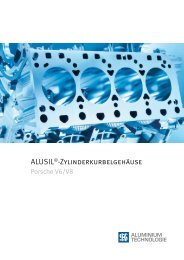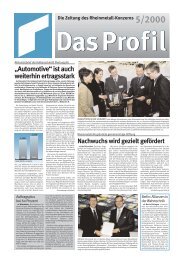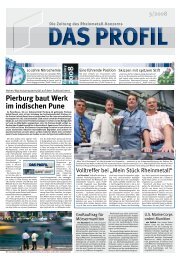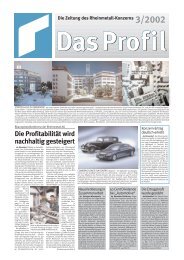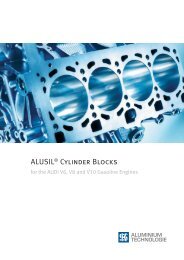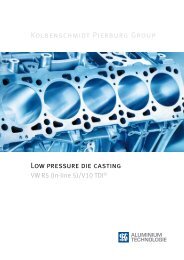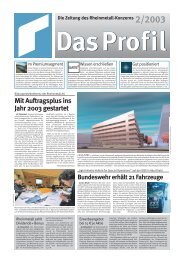Annual Report 2001 - KSPG AG
Annual Report 2001 - KSPG AG
Annual Report 2001 - KSPG AG
You also want an ePaper? Increase the reach of your titles
YUMPU automatically turns print PDFs into web optimized ePapers that Google loves.
80<br />
Consolidated financial statements <strong>2001</strong> of Kolbenschmidt Pierburg <strong>AG</strong><br />
Notes<br />
Accounting principles<br />
(6) Accounting and<br />
valuation methods<br />
The following unchanged useful lives<br />
underlie amortization:<br />
The following unchanged asset depreciation<br />
ranges (ADRs) apply to<br />
property, plant & equipment within<br />
tangible assets:<br />
Intangible assets<br />
Purchased intangible assets are capitalized<br />
at (acquisition) cost, internally<br />
created intangibles from which the<br />
Group is believed to derive future<br />
economic benefits and which can<br />
reliably be measured are recognized<br />
at production cost, either type of<br />
intangible asset being amortized by<br />
straight-line charges over the estimated<br />
useful life. Production cost covers<br />
all costs directly allocable to the production<br />
process, including any proratable<br />
production-related overheads.<br />
The cost of finance is not capitalized.<br />
R&D costs are principally expensed.<br />
Development costs are exceptionally<br />
capitalized and amortized on a<br />
straight-line basis if a newly developed<br />
product or process can be<br />
clearly defined, technologically realized<br />
and used either internally or is<br />
destined for marketing (IAS 38),<br />
and if there is a reasonable assurance<br />
that its costs will be recovered by<br />
future cash inflows. If certain factors<br />
hint at an impairment and the recoverable<br />
amount is below amortized<br />
cost, an intangible asset is written<br />
down. Wherever the reason for writedown<br />
has ceased to exist, the charge<br />
is reversed and the asset written up<br />
accordingly.<br />
Concessions, franchises, industrial property rights 2-20 years<br />
Development costs 5 years<br />
Goodwill from consolidation or the<br />
statement at equity is amortized<br />
over its estimated period of benefit,<br />
as a rule 15 to 20 years. The period<br />
is estimated with due regard to the<br />
Tangible assets<br />
Tangible assets are carried at depreciated<br />
cost less any write-down. The<br />
production cost of internally made<br />
tangible assets comprises all costs<br />
directly allocable to the production<br />
process, including the proratable production-related<br />
overheads. Borrowing<br />
expected benefits from the market<br />
position achieved through the acquisition<br />
and from the acquiree’s valueadding<br />
potential.<br />
costs are not capitalized as part of<br />
cost. Tangible assets are principally<br />
depreciated on a straight-line basis<br />
over their estimated useful lives unless<br />
in exceptional cases another<br />
method better reflects the pattern of<br />
use.<br />
IAS 40 is not applied since no investment<br />
properties exist.<br />
Buildings 20-77 years<br />
Other structures 8-20 years<br />
Production plant and machinery 3-20 years<br />
Other plant, factory and office equipment 2-23 years<br />
Tangible assets obtained under capital<br />
leases are capitalized at the lower<br />
of their fair values or the present value<br />
of minimum rents and depreciated<br />
over the shorter of their estimated<br />
useful lives or underlying lease terms<br />
(IAS 17). If certain factors hint at an<br />
impairment and the recoverable<br />
amount is below depreciated cost,<br />
a tangible asset is written down.<br />
Wherever the reason for write-down<br />
has ceased to exist, the charge is<br />
reversed and the asset written up<br />
accordingly.<br />
Financial assets The shares in nonconsolidated group Long-term loans bearing interest at<br />
companies and in associated affiliates<br />
not stated at equity and the other<br />
fair market rates are carried at par.<br />
long-term securities, all shown as The shares in associated affiliates<br />
financial assets, are carried at their and joint ventures disclosed as such<br />
fair values. The fair value of nonlisted are stated at equity. Based on the cost<br />
shares is derived from the going at share acquisition date, the invest-<br />
concern value, the latter being determent book value is increased or<br />
mined by means of generally accepted decreased to reflect the changes in<br />
appraisal and valuation techniques. equity of the associated affiliates or<br />
Changes in fair value are not recog- joint ventures to the extent such<br />
nized in income until realized. changes are allocable to the shares<br />
However, if a value has been impaired held by the Kolbenschmidt Pierburg<br />
and fallen below cost, even unrealized<br />
losses are recognized in net income.<br />
Group.<br />
Inventories and prepayments<br />
received<br />
Inventories are recognized at cost,<br />
as a rule applying the average-price<br />
method to acquisition cost whereas<br />
production cost includes the absorbed<br />
costs according to IAS 2 and is determined<br />
on the basis of normal workloads.<br />
Specifically, capitalized production<br />
cost comprises direct costs<br />
plus any portions of indirect materials,<br />
indirect manufacturing costs (labor,<br />
etc.), as well as production-related<br />
depreciation and pension expenses,<br />
but excludes any borrowing costs<br />
(IAS 23). Risks inherent in inventories<br />
due to reduced utility or to obsolescence<br />
are adequately allowed for. If<br />
the net realizable value (NRV) of any<br />
inventories at balance sheet date is<br />
below their carrying value, such in-<br />
ventories are written down to NRV.<br />
If the NRV of inventories previously<br />
written down has risen, the ensuing<br />
write-up is offset against cost of<br />
materials (raw materials and supplies)<br />
or shown as increase in inventories<br />
of finished products and work in<br />
process (WIP).<br />
Prepayments received from customers<br />
are recognized as liabilities.<br />
Receivables and sundry assets Receivables and sundry assets are fair-valued as of the balance sheet<br />
capitalized at cost. Adequate allowances<br />
provide for bad debts and<br />
doubtful accounts. Non-euro receivables<br />
are translated at the mean<br />
current rate. Short-term securities are<br />
date. Changes in fair value are not<br />
recognized in income until realized.<br />
However, if a value has been impaired<br />
and fallen below cost, even unrealized<br />
losses are recognized in net income.<br />
81



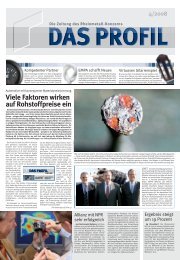
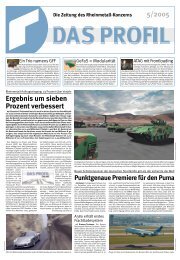
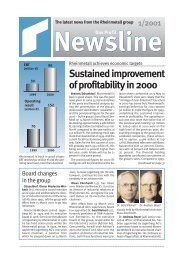
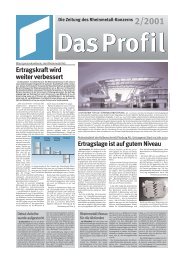
![PDF [1.0 MB] - KSPG AG](https://img.yumpu.com/5513074/1/171x260/pdf-10-mb-kspg-ag.jpg?quality=85)
